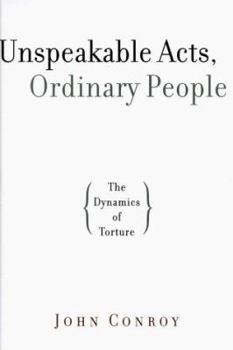Unspeakable Acts, Ordinary People: The Dynamics of Torture
Select Format
Select Condition 
Book Overview
Related Subjects
Anthropology Civics & Citizenship Civil Rights Civil Rights & Liberties Constitutional Law Cultural Education & Reference History Human Rights Humanities Law Modern (16th-21st Centuries) Political Science Politics & Government Politics & Social Sciences Public Policy Social Science Social Sciences Social Work Specific Topics Textbooks WorldCustomer Reviews
Rated 5 starsA powerful, but difficult read
Most of this book examines three case studies, from numerous different angles, unveiling the mentality of torturer and tortured alike. The breaking up of the three cases into non-sequential sections aids readability a bit, and the whole tone of the writing is very collected and non-sensational. It does a great job of pointing out not only the details of the individual cases, but the importance of those tortures as events for...
1Report
Rated 5 starsSickeningly Topical in 2004
"Unspeakable Acts, Ordinary People" is a thoughtful investigation of torture in the modern world. Conroy reconstructs three episodes: the torture of IRA suspects by the British Army in 1971; the torture of Palestinians by Israeli troops in 1988; and the torture of a cop-killing suspect by Chicago police in 1982. Along the way, he reflects on torture in countries such as Greece, Rhodesia, and Uruguay; he also explores the...
1Report
Rated 5 stars"A benchmark work in human rights literature"
The above quote comes from the brief biographical piece on John Conroy included in the online program for the 2000 Amnesty International USA Midwest Regional Conference, one of the many human rights forums at which he has lent his expertise on torture as a featured speaker. I agree with the view expressed in the quote completely - this book brilliantly illuminates some fundamental truths that we must face if we are to eliminate...
1Report
Rated 5 starsThe Torture Is Not in the Writing: A Clean and Clear Book
Unlike books in which the cover promises much more than the author delivers, this one reflects "truth in advertising." The title and content fit together beautifully.There may be better ways to illustrate the profound and disturbing fact that, given the right circumstances, ordinary people can and do commit unspeakable acts, but I doubt it. In an area in which authors seemingly find it easy to draw conclusions beyond their...
1Report
Rated 5 starsSpeaking About the Unspeakeable
Unspeakable Acts, Ordinary People by John ConroyIn 1975 the United Nations defined torture as "any act by which severe pain or suffering, whether physical or mental, is intentionally inflicted by or at the instigation of a public official on a person for such purposes as obtaining from him or a third person information or confession, punishing him for an act he has committed, or intimidating him or other persons...Torture...
1Report













